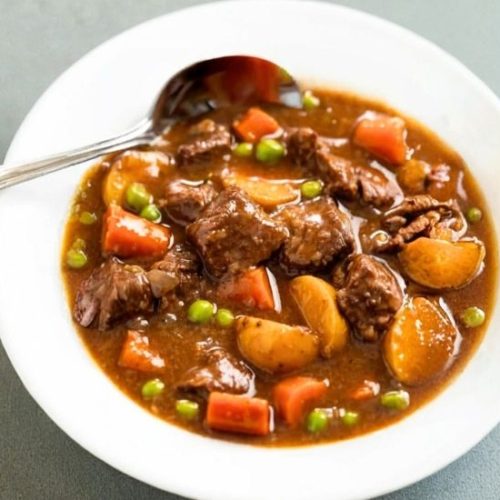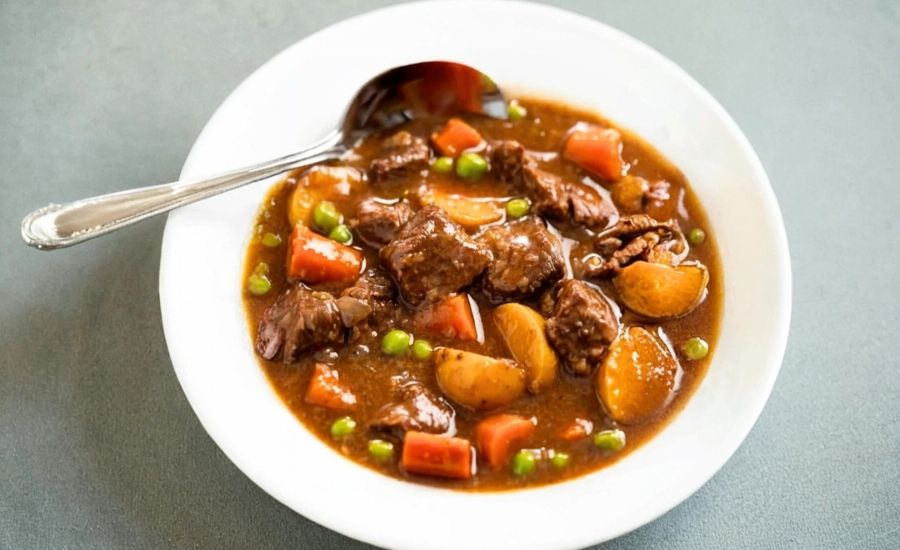All products are selected by our editorial team for quality. If you buy through our links, we may earn a small commission at no extra cost to you.
This Slow Cooker Beef Stew is a comforting classic that brings warmth and hearty satisfaction to your table, especially during colder months.
What makes it truly special is the blend of tender, protein-rich beef slow-cooked to perfection alongside nutrient-dense vegetables like carrots, potatoes, and peas.
The use of red wine adds a rich depth of flavor while enhancing the tenderness of the meat.
Nutritionally, this stew delivers a robust 49 grams of protein per serving, essential for muscle repair and satiety, balanced with fiber-rich vegetables to support digestion.
Though it contains moderate fat, the inclusion of heart-healthy olive oil and controlled amounts of butter ensures a balanced fat profile with some good fats and limited saturated fat.
Beyond health benefits, this recipe excels in ease and versatility—prepping takes only 20 minutes, then the slow cooker does the work.
It’s ideal for meal prepping or family dinners, offering a delicious, satisfying meal without constant monitoring.
Plus, the option to customize with additional vegetables or wine substitutes makes it adaptable to various tastes and dietary needs.
Must-Have Tools for Perfect Results
6-Quart Slow Cooker
The heart of this recipe, a 6-quart slow cooker allows for even, low-temperature cooking that tenderizes beef beautifully while melding flavors over hours.
Beyond this stew, it’s invaluable for effortless meal prep, soups, and stews.
Large Skillet (preferably non-stick or cast iron)
Essential for searing the beef to develop a rich, caramelized crust and for sautéing onions and garlic.
A versatile pan that excels at browning, stir-frying, and pan-searing in everyday cooking.
Silicone Spatula
Perfect for deglazing the skillet with wine and scraping flavorful browned bits without scratching your cookware.
Its heat resistance and flexibility make it a kitchen staple for mixing, folding, and scraping.
Measuring Cups and Spoons
Accurate measurements of spices, liquids, and starches are crucial for balancing flavors and consistency, especially when thickening the stew.
Precise tools elevate your cooking from good to great.
Mixing Bowl
Handy for tossing beef cubes with seasoning and flour to ensure even coating before searing.
A must-have multipurpose kitchen item for prep, mixing batters, and marinating.

Slow Cooker Beef Stew
Equipment
- 1 6-Quart Slow Cooker
- 1 Large Skillet (non-stick or cast iron recommended)
- 1 Silicone Spatula
- Measuring cups and spoons
- Mixing Bowl
Ingredients
- 2 ½ pounds beef stew meat trimmed and cut into 1-inch cubes
- ½ teaspoon black pepper
- ½ teaspoon garlic salt
- ½ teaspoon celery salt
- ¼ cup all-purpose flour
- 3 to 6 tablespoons olive oil divided
- 3 tablespoons cold unsalted butter divided
- 2 cups diced yellow onions
- 4 garlic cloves finely minced
- 1 cup dry red wine Cabernet Sauvignon or Merlot preferred
- 4 cups beef broth
- 2 beef bouillon cubes
- 2 tablespoons Worcestershire sauce
- 3 tablespoons tomato paste
- 5 medium carrots cut into 1-inch pieces
- 1 pound baby Yukon Gold potatoes halved or quartered
- 2 bay leaves
- 1 fresh rosemary sprig
- 1 cup frozen peas
- ¼ cup cold water for optional thickening
- 3 tablespoons cornstarch for optional thickening
- 2 to 3 drops Gravy Master optional, for richer color
Instructions
- Prepare and Season the Beef: Start by trimming any large pieces of fat from the stew meat, leaving some marbling for flavor.Pat the beef cubes dry, then sprinkle evenly with black pepper, garlic salt, and celery salt. Toss to coat thoroughly. Next, sprinkle the flour over the seasoned beef and mix well to cover all pieces evenly. This coating will help thicken the stew as it cooks.
- Brown the Meat: Heat 3 tablespoons of olive oil in a large skillet over medium-high heat. Add the beef cubes in small batches, making sure not to crowd the pan. Brown each side for about 45 seconds until a golden crust forms, adding more oil if necessary between batches. Once browned, transfer the beef pieces to your slow cooker.
- Sauté Onions and Garlic: Reduce the skillet heat to medium. Melt 1 tablespoon of cold butter, then add the diced onions. Cook, stirring occasionally, until the onions soften and become translucent, about 5 minutes. Stir in the minced garlic and cook for an additional minute until fragrant.
- Deglaze the Skillet: Pour a splash of the red wine into the skillet to loosen any browned bits stuck to the bottom — these bits pack a lot of flavor. Use a silicone spatula to scrape and mix the flavorful residue into the wine. Then, transfer the entire onion and garlic mixture into the slow cooker with the beef.
- Add Remaining Ingredients: To the slow cooker, add the rest of the red wine, beef broth, bouillon cubes, Worcestershire sauce, tomato paste, carrots, potatoes, bay leaves, and rosemary sprig. Stir gently to combine all ingredients.
- Slow Cook the Stew: Cover and cook the stew on low for 7 to 8 hours, or on high for 3 ½ to 4 hours. The stew is done when the vegetables are tender and the beef is fork-tender.
- Add Peas and Finish: About 15 minutes before the cooking time ends, stir in the frozen peas. Remove the bay leaves and rosemary sprig before serving.
- Optional Thickening and Finishing Touch: If you prefer a thicker stew, whisk together the cold water and cornstarch until smooth. Slowly pour this mixture into the stew while stirring. Allow the stew to cook for a few more minutes to thicken. Finally, stir in 2 tablespoons of cold butter to create a silky, rich finish. For a deeper color, you can add a few drops of Gravy Master.
Notes
- Choosing the Beef: Chuck roast is ideal for stew due to its marbling and tenderness after slow cooking. Alternatives like rump roast or bottom round can also work well. For less moisture loss, you can sear a whole roast before cubing, but this reduces seasoning surface area.
- Wine Alternatives: If you prefer not to use wine, substitute with equal parts beef broth or red grape juice mixed with 2 tablespoons of red wine vinegar to maintain acidity and tenderize the meat. For an Irish twist, replace the wine with 1 cup of Guinness stout.
- Additional Vegetables: Feel free to add celery, green beans, parsnips, or sweet potatoes to diversify flavors and textures.
- Storage Tips: Store leftover stew in airtight containers in the refrigerator for up to 3 days or freeze for up to 3 months. Reheat gently to preserve texture.
- Serving Suggestions: Serve this stew with crusty bread, over buttered noodles, or with a side salad for a complete meal.
Chef’s Secrets to Tender Stew
Achieving melt-in-your-mouth beef in this stew begins with properly seasoning and browning the meat.
Coating the beef cubes in flour before searing not only enhances flavor but also helps thicken the stew later.
Be sure not to overcrowd the pan during browning—this ensures a rich, caramelized crust that deepens the stew’s taste.
Deglazing the skillet with red wine lifts those flavorful browned bits, infusing the broth with complexity.
Slow cooking on low heat allows connective tissues to break down gently, resulting in juicy, tender meat and perfectly cooked vegetables.
Adding cold butter at the end (a technique known as monter au beurre) enriches the broth, giving it a luxurious, velvety texture that elevates this humble stew into a comforting gourmet meal.
Serving Suggestions That Impress Guests
This hearty beef stew pairs wonderfully with rustic crusty bread to soak up every drop of its rich broth.
For a classic combination, serve alongside creamy mashed potatoes or buttered egg noodles, which complement the stew’s robust flavors.
Adding a fresh green salad with a tangy vinaigrette can provide a refreshing contrast.
For a more casual meal, try it over steamed rice or with a side of roasted root vegetables for extra heartiness.
Garnishing with freshly chopped parsley or a sprinkle of grated Parmesan adds color and a hint of brightness, making it as visually appealing as it is delicious.
Storage Tips for Maximum Freshness
Store leftover stew in airtight containers once completely cooled to preserve flavor and texture.
Refrigerate for up to three days, reheating gently over low heat on the stovetop or in the microwave to avoid toughening the meat.
For longer storage, freeze portions in freezer-safe containers or heavy-duty zip-top bags for up to three months.
When reheating from frozen, thaw in the refrigerator overnight and warm slowly.
To maintain the stew’s ideal consistency, avoid over-thickening during reheating; you can always add a splash of beef broth or water to loosen it up.
Proper storage ensures you have a delicious, ready-to-eat meal waiting for busy days.
Frequently Asked Questions About Stew
1. Can I use a different cut of beef?
Yes! Chuck roast is ideal for slow cooking due to its marbling, but rump roast or bottom round can also work well. Avoid lean cuts, as they tend to become tough.
2. What if I don’t want to use wine?
You can substitute the wine with equal parts beef broth or red grape juice combined with 2 tablespoons of red wine vinegar to mimic the acidity and flavor depth.
3. How do I thicken the stew if it’s too watery?
Mix cold water with cornstarch and stir it into the stew near the end of cooking. Let it simmer a few minutes until it thickens to your liking.
4. Can I add other vegetables?
Absolutely! Celery, green beans, parsnips, or sweet potatoes are excellent additions that complement the flavors and add texture.
5. Is it better to cook on low or high?
Cooking on low for 7-8 hours yields the most tender beef and well-developed flavors, but if you’re short on time, cooking on high for 3.5-4 hours will also produce delicious results.
This recipe is inspired by thecozycook and has been carefully refined to enhance clarity, streamline preparation steps, and ensure accurate results. We’ve also included health benefits, nutritional highlights, and Must-Have Tools to help you get the best results every time you cook.


